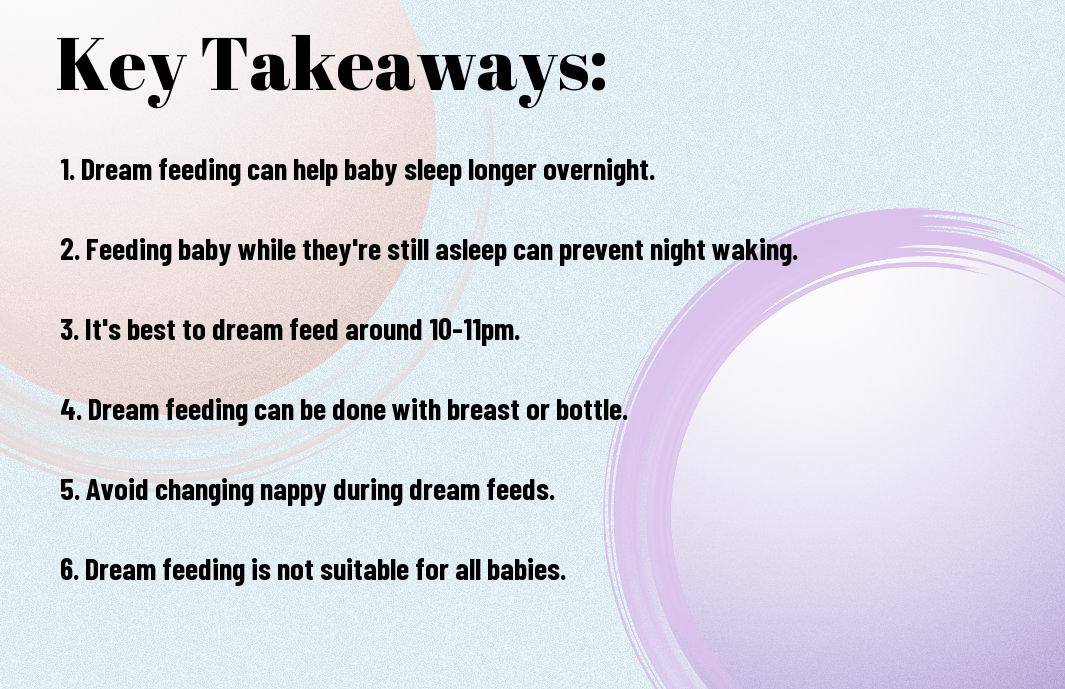tips, tricks and guides for parenthood
Are sleepless nights taking a toll on you as a new parent? Dream feeding, the practice of feeding your baby right before you head to bed, could be the solution to preventing night waking. This technique involves rousing your little one gently for a quiet feed, ensuring their tummy is full and they sleep longer stretches, giving you some much-needed rest. In this blog post, we will investigate into the benefits of dream feeding and how to incorporate it into your bedtime routine to promote better sleep for both you and your baby.

Preparing for dream feeding involves ensuring that your baby is in a quiet and dimly lit environment, as this will help to keep them in a sleepy state. Have all the necessary supplies, such as a bottle or breast, within arm's reach to minimise disturbance during the feeding.
The optimal timing for dream feeding is when your baby has been asleep for a few hours but not in a deep sleep. This usually occurs around 10 pm to 11 pm, before your own bedtime. It's important to find the right balance so that your baby is not too drowsy to feed but also not fully awake.
During this period, babies are more likely to rouse slightly during their sleep cycle, making them more receptive to feeding without fully waking up. This allows them to top up their feeds and may help them sleep for longer stretches through the night.
When implementing dream feeding into your routine, it is important to establish a consistent nighttime schedule for your baby. This involves feeding your little one at the same time each night, just before you go to bed. By sticking to a regular routine, you can help your baby adapt to the dream feeding process and promote better sleep patterns.
Despite your best efforts, you may encounter some common issues when trying to implement dream feeding. One of the most common problems is when your baby wakes up during the feeding or struggles to latch on. To troubleshoot these issues, try to keep the environment calm and soothing, use a dim light if needed, and gently guide your baby to latch on properly. It may take some time for your baby to get used to dream feeding, so be patient and consistent in your approach.
Dream feeding, popularised by The Dream Feed, involves feeding your baby whilst they are still asleep, typically right before you go to bed. This practice aims to prevent your baby from waking up during the night for a feed, allowing both you and your baby to get longer stretches of uninterrupted sleep. By strategically timing a dream feed, you can help regulate your baby's overnight feeding routine and encourage healthier sleep patterns.
As your baby grows, their sleep patterns and feeding needs will naturally evolve. It is important to adapt your dream feeding routine to accommodate these developmental changes. Keep an eye on your baby's cues and adjust the timing and frequency of dream feeds accordingly. By staying attuned to your baby's changing requirements, you can continue to use dream feeding effectively to support better sleep for both you and your little one.
Dream feeding can be a useful technique for parents looking to prevent night waking in their baby. By feeding your baby right before you go to sleep, you can help them stay full for longer periods and have more extended periods of sleep during the night. However, it is important to ensure that you do not fully wake your baby during this process, as it can have the opposite effect and disrupt their sleep patterns. By following the correct steps and being consistent, dream feeding can be an effective tool in helping both you and your baby get a better night's sleep.
A: Dream feeding is a method where you feed your baby right before you go to sleep, typically between 10pm and midnight, to help prevent night waking.
A: Dream feeding can top up your baby's tummy, so they sleep for a longer stretch before needing to feed again, reducing the chances of them waking up hungry during the night.
A: The best time to dream feed a baby is when you are going to bed, usually between 10pm and midnight, to ensure they are more settled and less likely to wake up shortly after being fed.
A: Dream feeding may not be suitable for breastfed babies as it could affect milk supply. It is recommended to consult with a healthcare provider before trying dream feeding with your baby.
A: To make dream feeding successful, ensure you do it in a dimly lit room with minimal interaction to avoid fully waking up your baby. Keep the feeding session calm and quiet to help them drift back to sleep easily.